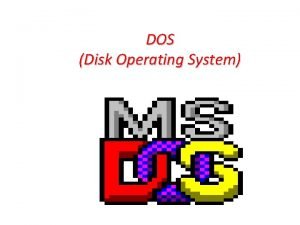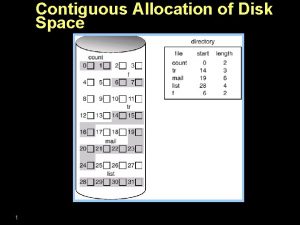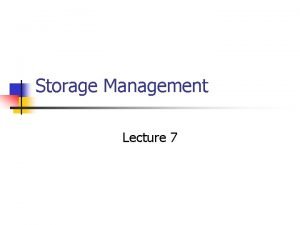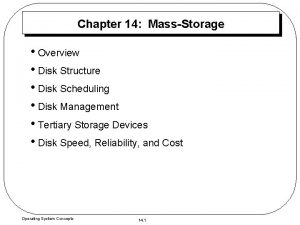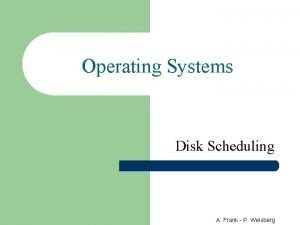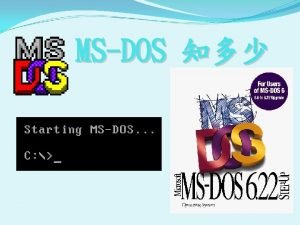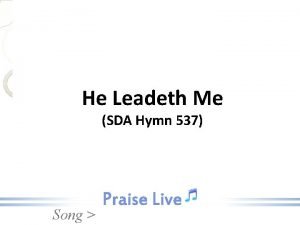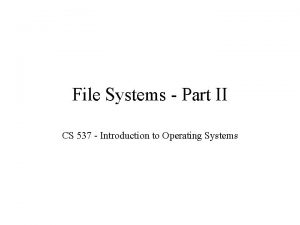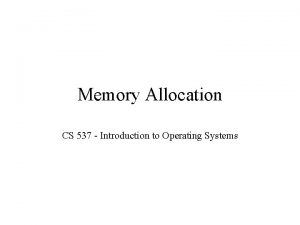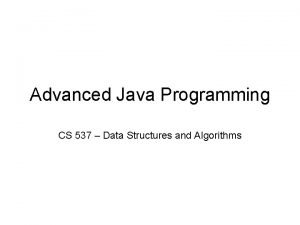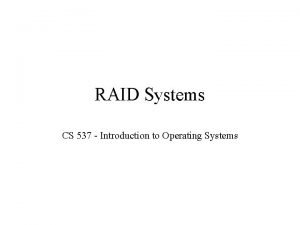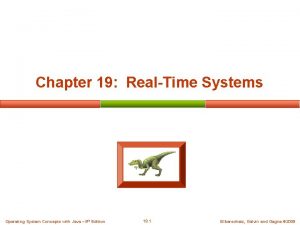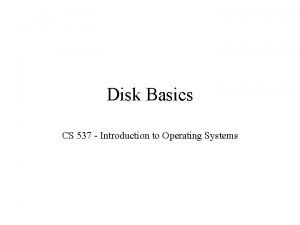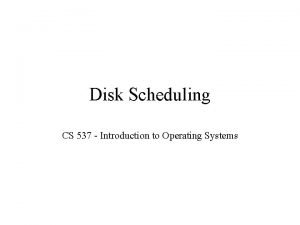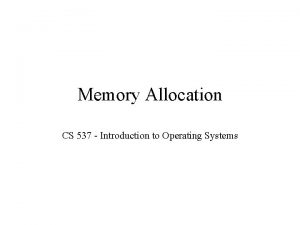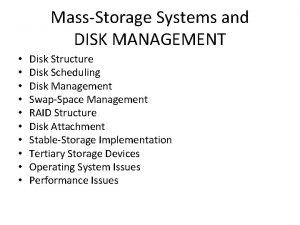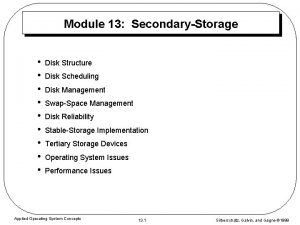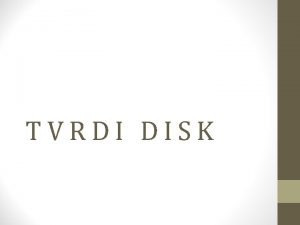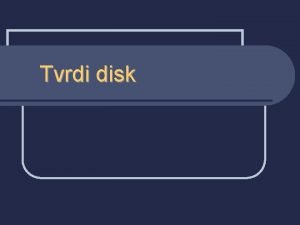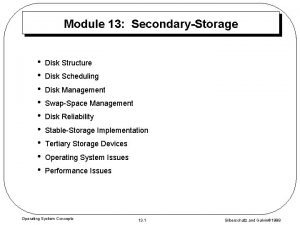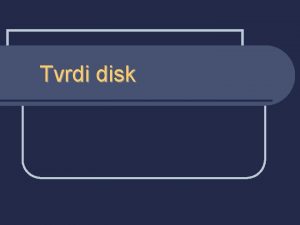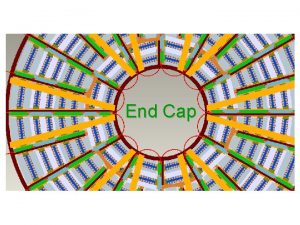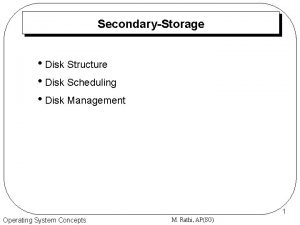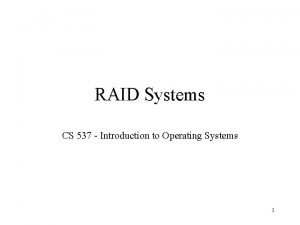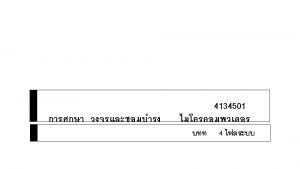Disk Allocation CS 537 Introduction to Operating Systems





























- Slides: 29

Disk Allocation CS 537 - Introduction to Operating Systems

Free Space • Need to keep track of which blocks on a disk are free • Disk space is allocated by sectors – 512 bytes typically • The list of free blocks is also stored on disk

Bit Vector • A very simple method is to keep a single bit for each block on disk • Example – Free blocks: 2, 5, 13, 14, 15, 23, 24, 29, 31, … – Bit Vector: 0010010000000110000101… • Requires the use of some disk space – a 16 GB disk would require 8192 blocks to map free list (assuming 512 byte blocks) – roughly 0. 025% of entire disk space

Bit Vector • Fairly simple to implement – requires hardware support for bit manipulation • Biggest advantage is the ability to select whichever block – can be used to pick adjacent blocks for a file • For good performance, cache the bit vector in memory – allows for fast lookup of available blocks – need to write the vector back to disk frequently • crash recovery

Linked List • Keep a pointer in each free block to the next free block • To find a free block, just grab the first block off the list • Problem arises if multiple free blocks are needed – have to follow links all over disk - poor performance

Grouped Linked List • A single free block will point to a group of other free blocks • Consider the following free blocks – 2, 5, 13, 14, 15, 23, 24, 29, 31, 37, 38, 41, … 2 pointer to next free list block 5 13 14 15 23 24 29 29 31 37 38 41 42 56 61

Grouped Linked List • The last entry in each group points to another free block with pointers to more free blocks • When all the blocks in a group have been allocated, then use the block that held the pointers • Requires no disk space for implementing – just need to store the location of the first pointer block

Clusters • Disk blocks are 512 bytes • Most file systems group several blocks together to form a cluster – 1 K, 4 K, 16 K, etc. • Lowest levels of OS must deal with physical sectors • Everything else can work on clusters – this includes the file system – think of them as logical sectors

Clusters • 4 KB cluster fits nicely into a single page of memory • This helps in prefetching data • Internal fragmentation is now worse – not bad though if the average file is near 4 KB – or if most files are very large

Clusters • Reconsider the bit vector requirements – 16 GB disk using 4 KB clusters – each bit in the vector now represents 8 physical sectors – total memory requirements are now 1024 physical sectors

File Space Allocation • Basic issues – most files change size over there life time – some files tend to be read sequentially • would like to allocate space sequentially on disk – some files are not read sequentially • database files for example • would still like to have decent performance – files are continuously created and deleted • this could cause fragmentation of disk – disks are slow • most information will be cached in memory

Contiguous Allocation • When a file is first created, give it a set of contiguous blocks on disk • Simple method to implement – just search free list for correct number of consecutive blocks and mark them as used • Supports sequential access very well – files entire data is stored in adjacent blocks • Also supports random access well – quick and easy to determine where any piece of data lives

Contiguous Allocation 1 1 1 0 0 0 1 1 0 Current Disk Allocation Newly created file This file could start in any of the blocks 3 through 6 1 1 1 0 0

Contiguous Allocation • Several big problems with this method – External fragmentation of disk – How to determine how much space a file should be given • default value? user defined? – What happens if file needs to grow beyond allocated space? • don’t let it happen? copy it to a bigger space?

Linked Allocation • Keep a pointer in each file block to the next block of the file • Simple to imlement – directory just needs to keep track of the first block in the file • Allows file to easily grow • No external fragmentation

Linked Allocation directory test. c 7 last block in the file 0 1 -1 2 -1 3 -1 4 5 5 -1 6 1 current disk allocation 7 -1 8 3 9 -1 -1

Linked Allocation • A few problems with this method – a small portion of a files space is used for pointers instead of for data • not a huge issue – to find a random byte in the file, must search through all the other blocks to find the right pointer • poor for performance in non-sequential accesses • this is a huge issue

File Allocation Table (FAT) • This is an extension of the linked allocation • Instead of putting the pointers in the file, keep a table of the pointers around • This table can be quickly searched to find any random block in the file

FAT 0 1 2 3 4 5 6 7 8 9 directory test. c 7 last block in the file 0 1 2 3 4 5 current disk allocation eof 5 1 3 6 7 8 9

FAT • All the blocks on disk must be included in the table • Assume 4 KB clusters and 16 GB disk – number of entries in the FAT is about 4 million – assume each entry is 32 bits – size of the FAT is 128 MB • A nice side effect of FAT is for the free list – whether a block is free or not can be recorded in the table

FAT • For good performance, the FAT should be cached in memory – otherwise traversing the list would require many disk accesses to “follow” the pointers • This method works well for both sequential and random access • This is the method used by Windows

Indexed Allocation • Another solution is to record all of the locations of a files blocks in a separate “file” • This “file” is referred to as an index node – inode for short • It contains all the pointers to the blocks that a file currently owns

Indexed Allocation 7 3 5 -1 -1 0 directory 1 test. c 1 2 0 1 2 3 4 disk 5 6 7 8 9

Indexed Allocation • The amount of space a file can hold would be limited by the size of the inode – if only 10 entries fit in the inode, that would mean only 10 different blocks could be referenced • To represent a large file, would need large inodes • Large inode would be a waste of space for small files • Use indirection!

Indexed Allocation • Unix inodes are a total size of 128 bytes – the first part of an inode is the meta data for a file – a total of 13 pointers (each 4 bytes long) • There are 10 direct pointers – point directly to data blocks for the file • There is 1 indirect pointer – points to a block that contain only pointers to data blocks for the file • There also 1 doubly indirect and 1 triply indirect pointers

Indexed Allocation Meta Data 0 1 2 3 4 5 6 7 8 9 10 11 12 Data Block . . . Data Block indirect block triply indirect block doubly indirect

Indexed Allocation • Small files will use the direct pointers – little overall wasted space • Large files will use the indirect pointers – allows for huge files • Maximum number of pointers in an indirect block is 512/4 = 128 pointers • Maximum file size (in blocks) is – 10 + 128*128 2 million blocks

Indexed Allocation • Where are the inodes stored? – in fixed location at beginning of disk – think of it as a big table of inodes – the root directory is stored at location 0 in the table

Indexed Allocation • To read a single data block may require multiple accesses to disk – need to go through indirect pointers • CACHE! – place a referenced inode and subsequent indirect pointer blocks into memory and access there
 Operating system
Operating system Contiguous allocation vs linked allocation
Contiguous allocation vs linked allocation Disk storage types
Disk storage types What is dual mode in os
What is dual mode in os Ms dos 1
Ms dos 1 Moving head disk mechanism
Moving head disk mechanism What is disk scheduling in os
What is disk scheduling in os Microsoft disk operating system
Microsoft disk operating system Sda hymn 537
Sda hymn 537 Cs537
Cs537 Buddy system memory allocation
Buddy system memory allocation Cs 537
Cs 537 Cs 537
Cs 537 Cs 537
Cs 537 537-317-757
537-317-757 Example of oprating system
Example of oprating system Evolution of operating systems
Evolution of operating systems Components of an operating system
Components of an operating system Os components
Os components Wsn operating systems
Wsn operating systems Operating systems: three easy pieces
Operating systems: three easy pieces Operating systems lab
Operating systems lab Modern operating systems
Modern operating systems Components of operating system
Components of operating system Design issues of distributed operating system
Design issues of distributed operating system Early operating systems
Early operating systems Real-time operating systems
Real-time operating systems Can we make operating systems reliable and secure
Can we make operating systems reliable and secure Alternative operating systems
Alternative operating systems Exo kernel
Exo kernel
